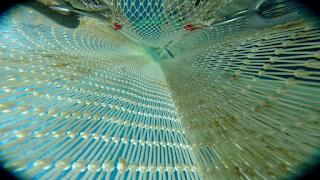My name is Alessandro, a master
student from Wageningen University. I joined this research cruise last Sunday,
in Aberdeen. The aim of my MSc project is real-time fish species and size
specific discrimination using acoustic backscattering data, which can be quite
challenging among species that show similar acoustic responses. In this
respect, the new broadband echosounder EK80 uncovers new possibilities, as we
become able to study the fish school’s frequency response (intensity of sound
reflected at different frequencies) over the complete spectrum 17-460 kHz. To
do so, we need clear and consistent data in order to calibrate and validate an
identification algorithm in the next months.
When passing through several fish
schools and observing a pure catch of a certain species in the net, it is quite
reasonable to think that all the aggregations seen on the screen belong to the
very one species. Likewise, it can happen to observe a broad variety of species
within the same catch, as it happened on Tuesday, July 6th fishing
on several schools around 52 12 N; 00 34 W (Haul 9).
The catch consisted of mixed
Norway Pout, Mackerel, Haddock, Whiting, Grey Gurnard, and Herring, for a total
of about one tonne.
 |
| Diverse species on the conveyor belt (Mackerel, Haddock, Norway Pout, Grey Gurnard) |
In these circumstances it becomes
quite hard to successfully distinguish the different caught species on the
echogram!
 |
| Which fish school belongs to Herring? Which one to Norway pout? |
Thanks to the trawl camera we can
attempt to track the history of the fishing session, connecting each school on
the echogram to the related species observed with the camera.
 |
| A group of 13-16 cm Norway Pout entering the net at GMT 12:19:40 |
 |
A mix of Haddock and
Whiting caught at GMT 12:30:25
|
 |
| Probable localisation of Norway Pout school after our reconstruction: to do this, we took into account the distance between the transducer and the trawl camera, along with the boat speed |
However, for the best performance in species identification we hope for pure catches in the next days. Especially Norway Pout and Herring will be targeted, since it appears to be quite difficult to distinguish them acoustically.
In the meanwhile, I’m helping
HendrikJan in sampling catches, taking measurements and collecting otoliths for
the Herring survey, to get a more complete insight of the life on a research
vessel!
















































